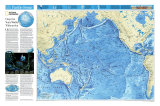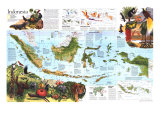The Western Pacific Rim map features:
• An article on the sweeping social and economic changes taking place in the region
• Information about industries, imports, exports, government, and population trends
• Information about nuclear testing issues and oceanic nuclear test sites
• Air hubs, major sea-lanes, strategic waterways, and fiber optic communication cables
• Military facilities, communication facilities, and Western Pacific Rim disputes
• Intraregional trade partners, selected regional associations, major specialized ports, mineral resources, and principal trade commodities
• Average gross national product per capita late 1980s
* Lesson plan idea - have your students update the information, discuss the political, economic, and environmental situations at time of publication and at date of their research. • maps
Western Pacific Rim - Economic Engine
EXAM QUESTION: Predict the economic progress of western Pacific countries in the year 2015.
The year is 2010. The world has entered the age of the Pacific. Geography students have been asked to analyze part of the complex region still undergoing extraordinary changes. Many of the approximately 23 western Pacific countries continue to post dizzying economic growth. A few remain mired in poverty and political disarray, but other are industrialized and democratic, able to feed themselves and no longer thwarted by runaway population growth. The success of the Pacific Community, organized in 2005, flouts the onetime belief that the peoples of the Pacific Basin would never overcome deep ethnic, cultrual, and political differences.
Turning to their computers, the students find a message from their professor: “Always look back before you look forward. Consider the following report written at the end of the 1980s–a pivotal decade for the western rim of the Pacific.”
During the 1980s, for the first time, the value of goods flowing between the United States – the world's largest economy – and the western Pacific exceeded the value of those flowing between the U.S. and Western Europe. Trade within the western Pacific, a potentially huge market with roughly a third of the world's 5.2 billion people, has continued to expand, making up more than thirty percent of all traffic on the Pacific Ocean. Aware of the western Pacific's growing economic and political clout, Australia and New Zealand are forging close ties with culturally dissimilar neighbors.
Alliances such as the Association of Southeast Asian nations (ASEAN) have helped nations pull together, especially in matters of defense and trade. Trade is a powerful binding force, but space-age communications, foreign aid, and tourism also knit the region. Not all countries are unified in prosperity. War-torn Cambodia, devastated Vietnam, the Philippines – only recently released from corrupt rule – and many poor islands in the South Pacific are struggling. Yet enough economies are performing so mightily that the western Pacific rim is an engine of world growth.
Japan is its dynamo. National will and U.S. grants of 1.7 billion dollars between 1946 and 1952 helped the Japanese rebuild after World War II. The economy grew by more than twice the world average until the early 1970s, fueled by exports of steel, ships, and chemicals. This miraculous economic surge also lay in a genius for improving Western consumer good such as cameras, electronics, and automobiles; Japan's inexpensive, fuel-saving cars soon left Detroit's guzzlers in the rearview mirror. Japanese companies applied efficient management and production strategies and cornered markets worldwide for their products. For Australia, Indonesia, Malaysia, New Zealand, and other suppliers of raw materials and foodstuffs, trade with Japan has been double-edged: fat profits at the cost of growing dependence.
Japan in the 1980s exhibits not only the strength of a sumo wrestler but also the flexibility of an Olympic figure skater. Japanese firms are gliding alongside their U.S. rivals in semiconductors, advanced structural materials, and biotechnology and are closing the gap in data processing and telecommunications. Between 1982 and 1986 Japanese companies spent twice as much on computer-controlled tools for their factories as did U.S. corporations. In an era of instant exchanges of ideas – and money – Tokyo's stock market now does ore business than New York's and nine of the world's ten largest banks are Japanese.
Japanese yen help bankroll Taiwan, South Korea, Hong Kong, and Singapore – known as newly industrialized economies (NIEs) and nicknamed “little dragons” for the fiery growth of their exports. Taiwan and South Korea, occupied by Japan before World War II, have capitalized on the Japanese legacy of agricultural innovation and high literacy. U.S. initiated land reforms after 1945 boosted farm productivity, freeing hands for factory work. The British colony of Hong Kong funnels a greater tonnage of goods into and out of China than does any other port. The city-state of Singapore, Southeast Asia's busiest entreport, served also as a financial bridege between the East and the West. Both Hong Kong and Singapore wield industrial strength far beyond their size.
How do these little dragons breathe fire? Buddhist and Confucian ideals are important, emphasizing education, hard work, respect for group authority, and frugality. The average Japanese family saves 20 percent of its income, whereas the average American family sets aside about 5 percent. Amercian consumerism and investment, access to U.S. markets, technology, and ideas–all are crucial. A relatively stable political climate, maintained with the help of the U.S. military presence in the Pacific, favors business, and America's free-enterprise system, based on individul entrepreneurship and an open marketplace, provides a successful economic model. Group-oriented East Asian societies have adapted it with magical results, their hybrids hinging on central-government manipulation of free-market forces.
The magic seems to be rubbing off. Malaysia, Thailand, the Philippines, and Indonesia – heirs apparent to the wizardry – are gaining momentum on the path from farm to factory and beyond. But they must overcome many obstacles: population pressure, political turmoil, foreign debt, lack of skilled labor, and environmental destruction. If they succeed and in turn galvanize the poorer countries, the 21st century could, as some predict, carry the world into a new era – the age of the Pacific.
A Bonanza of Exports
Large volumes of raw materials flow into Japan and other industrial nations in the western Pacific, and huge quantities of high-qualtiy manufactured goods are shipped out. Western Pacific exports to North America worth 150 billion dollars–almost twice the value of the region's exports to Europe–dominate the trade-flow map ... By 1985 Japan, which sends almost 40 percent of its merchandise to the United States, had become the world's largest creditor nation. Meanwhile the U.S., which keeps its doors open to most foreign products, had emerged as the largest debtor nation. For the past several years the U.S. deficit with Japan has tallied up to about 55 billion dollars–one-third of America's total yearly shortfall.
Where the People Are
In valleys and along coastal plains, where populations are densest, comecities are growingfaster than jobs become available. Complex migration patterns and a splintered geography have given rise to extraordinary diversity. Indonesia's more than 13,660 islands contain 300 ethnic groups speaking at least 250 languages and dialects; with 162 million Muslims, it is the world's largest Islamic country. The legacy of 150 years of tumult in China, about 16 million ethnic Chinese help run the business of Malaysia, Indonesia, Thailand, and the Philippines. Since 1975 some two million refugees have fled Vietnam, Laos, and Cambodia for China and way stations such as Thailand, Hong Kong, and Malaysia to await permanent resettlement.
Strategic Pacific
The ocean looked peaceful–pacific–to European explorer Ferdinand Magellan, who named it in the 1500s, but wars have buffeted its scattered territories. In 1898 the U.S. seized the Philippines from Spain and won control over Hawaii, Guam, and other islands. Japan's quest for domination of the Pacific, begun in the 1930s, was ended by the U.S. in 1945. communist North Korea invaded South Korea in 1950, and the U.S.-led counter-offensive brought a cease-fire in 1953. Today 48,000 Americans help guard South Korea's border. The war in Vietnam began for America in the early 1960s and dragged on for more than a decade.
Until recently the U.S. maintained naval superiority over the U.S.S.R. in the Pacific–through military alliances with Japan and others, strategic bases such as Clark Air Base and Subic Bay Naval Base in the Philippies, and satellite relay stations such as Pine Gap in central Australia. A U.S. naval control center on Guam helps conventional forces protect sea-lanes and choke points use by tankers bringing Middle East oil to Japan and other industrial consumers in the region.
Since the mid-1970s, however, the Soviet Union (Russia) has bolstered its Pacific fleet, depriving the U.S. of its advantage and worrying Japan. Yet Mikhail Gorgachev's Soviet Union appears more interested in economic growth than military conquest, and an end to Vietnam's Soviet-backed invasion of Cambodia reflects this hands-off approach. Economic aspirations and a trend toward domocracy are redrawing the geopolitical map. Now the two military superpoewers must not only weigh each other, and an unpredictable China, but also court an economic superpower – Japan – and powerful regional groupings.










